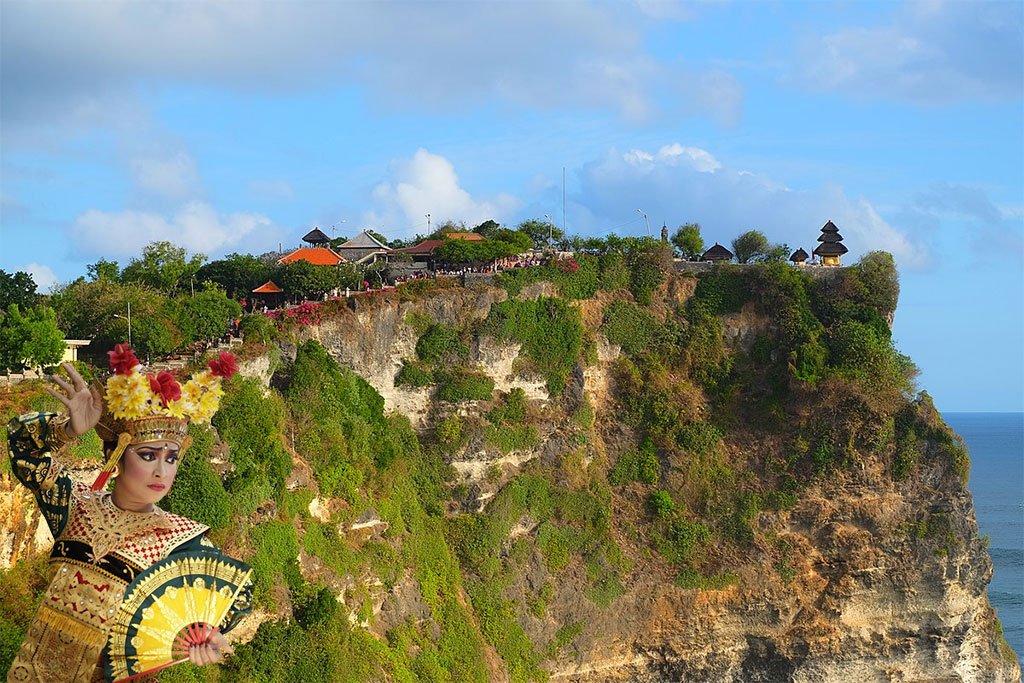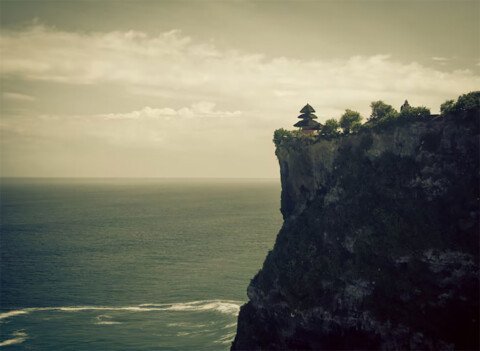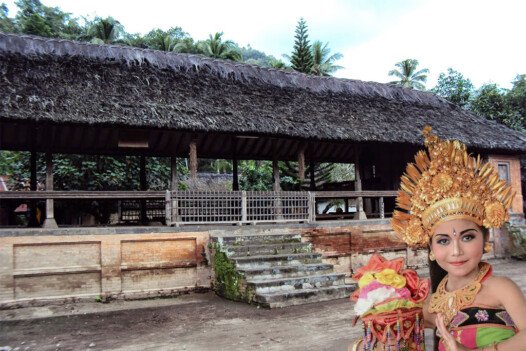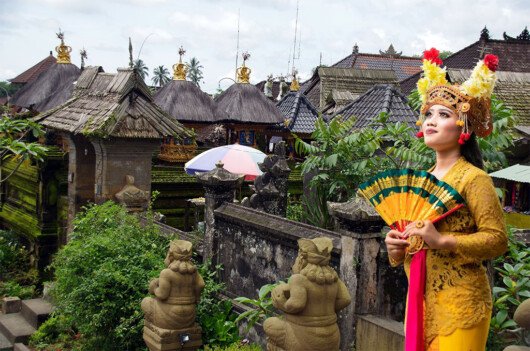Bali, known globally as the is a majestic tapestry of volcanic landscapes, emerald rice terraces, turquoise seas, and, most profoundly, an astonishing array of Hindu temples. Among them, three iconic sanctuaries stand above the rest: Uluwatu Temple, Tanah Lot Temple, and Besakih Temple. Each carries centuries of myth, architectural splendor, and spiritual magnetism. In this article, we’ll unveil their histories, legends, cultural significance, and suggestions to enhance your visit.
1. 🏞️ Uluwatu Temple (Pura Luhur Uluwatu)
Location & Setting
Perched dramatically atop a 70‑meter sheer cliff on Bali’s southwest coast, Uluwatu Temple offers one of the most stunning views of sunset over the Indian Ocean. Its local name, Pura Luhur Uluwatu, means the “Holy Temple at the Top of the Rock.”
Legend & Myth
This sacred sanctuary is believed to be one of the six key directional temples keeping Bali spiritually protected. Legend holds that it was established in the 10th century by Mpu Kuturan, but its prominence rose when Mpu Bharada, a priest from the Majapahit era in Java (13th century), consecrated the site.
A fascinating myth involves a rock the size of a cat found emerging from the cliff, considered to be the dwelling of a spirit. Mpu Bharada meditates there and tames the spirit, inviting it to join him. The spirit travels on the rock to Java and returns with him to Bali—hence the temple’s name, often translated as “the temple above the rock where one meditates and transforms (ulu-watu).”
Architectural Highlights
- Meru towers (multi-tiered shrines) dedicated to the sea gods and directional guardians.
- Sacred gates, ornately carved portals symbolizing entry into the divine realm.
- Pura Segara and Pura Api: smaller shrines honoring sea and fire deities.
- Balé segar & balé kulkul: traditional pavilions and drums used for ceremony calls.
Sacred Culture & Rituals
Uluwatu hosts frequent rituals and daily offerings to appease ocean spirits and thank deities for harmony and prosperity. Watch as priests and devotees in crisp white clothing perform vibrant ceremonies with offerings of flowers, rice, and incense.
Sunset Kecak Dance
Renowned worldwide, the Kecak (Monkey) Dance at Uluwatu is a theatrical marvel—a 90-minute performance of firelit chanting, monkey gods, and the timeless Ramayana epic. Begun in the 1950s as a cultural showcase, it’s an immersive sensory experience, especially against the backdrop of a blazing sunset sky.
Tips for Visiting Uluwatu
- Arrive at least 30 minutes before sunset for best seats in the open‑air theatre.
- Wear sarongs and respectful attire; they’re provided near the entrance.
- Beware of the infamous temple monkeys—guard your belongings!
- The trail around the cliff offers sensory delights from ocean breezes to the mischievous macaques.
2. 🌅 Tanah Lot Temple (Pura Tanah Lot)
Location & Setting
Iconic and globally recognized, Tanah Lot is a centuries‑old marvel built on a rocky islet about 100 meters offshore on Bali’s southwestern coast. When the tide is low, pilgrims can walk out; when high, it becomes a mysterious fortress floating on waves.
Legend & Myth
Legend credits Dang Hyang Nirartha, an esteemed 16th‑century Hindu priest, with discovering Tanah Lot. He journeyed Bali teaching and spreading Shaivite Hinduism. As dusk fell one day, Nirartha felt a divine presence on the rock and decided to build a shrine there. Stories say he banished evil spirits by summoning venomous sea snakes, which reputedly still guard the temple.
Additionally, a palm tree growing guard-like atop the islet was said to have grown from Nirartha’s stick, planted to eliminate evil and draw energy from the rock. The tree stands tall as a living part of the legend.
Architecture & Setting
- A compact structure comprising a central shrine, inner sanctum, and ceremonial space.
- During low tide, a narrow rock path allows pilgrims to wade across.
- Surrounding terraces at high tide are packed with photographers and visitors admiring the sight.
Spiritual Significance
Tanah Lot remains a key pilgrimage site. Major ceremonies tied to the Balinese Hindu calendar, like Melasti (purification before Nyepi) and Piodalan (temple anniversary), draw vast crowds. Many come to seek blessings tied to water, fertility, and longevity.
Tourist & Cultural Insights
- The area is surrounded by markets brimming with Balinese crafts, sarongs, and souvenirs.
- Dining spots with sea views offer serenity with seafood dishes and local cuisine.
- Honoring the tides, plan visits to correspond with low water, but expect larger crowds.
Tips for Visiting Tanah Lot
- Arrive early for sunrise serenity or late for sunset drama.
- Bring a sarong if you wish to enter or walk the path.
- Explore the small cultural park above the temple, with a towering statue of Dang Hyang Nirartha.
- Be mindful of slippery shale—wear sturdy footwear.
3. 🏔️ Besakih Temple (Pura Besakih)
Location & Setting
At nearly 1,000 meters above sea level, Besakih Temple—Bali’s largest and holiest—perches on the slopes of Mount Agung, Bali’s sacred volcano. This sprawling complex of 86 temples sprawls across terraced mountainsides, offering breathtaking views.
The central shrine, Pura Penataran Agung, features an eleven‑tiered meru tower dedicated to the supreme god, Sanghyang Widi.
Origins & Legend
With origins tracing back over a millennium, Besakih is considered Bali’s “Mother Temple.” Folklore speaks of descendants from heaven descending here to commence agriculture and Hinduism. Colonial explorers documented sacrifices and ceremonies dating back to the 10th century, reinforcing its antiquity.
Despite suffering damage during the massive 1963 eruption of Mount Agung—which blanketed the island in ash—Besakih survived largely intact, reinforcing its spiritual resilience. Its emergency ritual four months later invoked blessings of safety and rebirth for the island.
Pilgrimages & Rituals
- Odalan: the temple’s 210-day cycle celebrations are vibrant spectacles of ritual music, dance, and processions.
- Galungan and Kuningan festivals mark victory of dharma (good) over adharma (evil), bringing thousands to pray and celebrate.
- Piodalan is commemorated in every sub‑temple within the complex, each with its own unique date and rituals.
- Priests don traditional white attire, officiating offerings of betel, rice cakes, flowers, and incense.
Architectural Grandeur
- Intricate carvings and richly painted ceilings depict Hindu epics.
- Multiple layers of meru towers represent hierarchical realms—cosmic, spiritual, ancestral.
- Elevated terraces and stone staircases create awe-inspiring mini‑landscapes.
- Cliff‑facing shrines and gardens draw pilgrims toward nature and mountain backdrop.
Cultural & Historical Importance
As the symbolic source of spiritual energy, Besakih attracts not only tourists but also Balinese diaspora pilgrims. Each temple neighborhood has a community guardian overseeing rituals and upkeep—making Besakih a living, breathing cultural entity.
Visitor Experience
- Best to arrive early to avoid midday crowds and heat.
- Hire a local guide to appreciate the unique history of each sub‑temple.
- Respect ritual ceremonies—don’t intrude on processions or sacred offerings.
- Dress modestly, with sarong and sash; both can be rented at the gate.
- A gentle walk along the tiers offers sweeping views of Mount Agung, terraced landscapes, and cloud‑kissed peaks.
🧭 Comparing the Three Temples
| Attribute |
Uluwatu |
Tanah Lot |
Besakih |
| Location |
Southwest coast cliffs |
Southwest coast rocky islet |
Eastern slope of Mount Agung |
| Setting & Views |
Dramatic sunset over the ocean |
Picturesque sea temple & palm tree |
Mountainous temple complex on volcanic slope |
| Spiritual Role |
Guardian of southern sea direction |
Sea deity pilgrimage & water blessings |
“Mother Temple”, supreme cosmic axis |
| Historical Age |
10th–13th century origins |
16th century Dang Hyang Nirartha |
Over 1,000 years, pre‑Majapahit |
| Architectural Style |
Cliffside meru towers & gates |
Compact shrine, simple and serene |
Majestic towers & sprawling terrace layout |
| Cultural Experience |
Kecak dance, sunset rituals |
Pilgrimages, cultural park markets |
Grand festivals, daily temple rituals |
| Best Time to Visit |
Before sunset for Kecak performance |
Sunrise/early morning or sunset |
Morning; festivals seasonal |
✨ Planning Your Temple Tour
1. Timing & Seasons
- Dry Season (April–October): Clear skies, ideal for temple visits. Evenings can be pleasantly warm.
- Rainy Season (November–March): May occasionally disrupt ceremonies or performances.
- Temple Calendars: Balinese use a 210‑day Pawukon cycle. Lookup Piodalan dates for each temple when planning extended stays.
2. Clothing & Etiquette
- Dress code: Mandatory sarong and sash; provided at temple entrances.
- Behavior: No shorts or sleeveless tops. Enter gates with right shoulder turning inward. Avoid stepping over offerings.
- Photography: Allowed, but be respectful during ceremonies; don’t point feet toward altars or climb restricted areas.
3. Health & Safety
- Hydration is crucial; early morning or twilight visits reduce heat exposure.
- Monkey caution at Uluwatu: They may snatch loose items such as sunglasses.
- Terrain concerns: Wear good walking shoes—steps and rocky paths abound.
4. Getting There
- Private transport (driver/car or scooter) is the easiest to reach all three temples in a day.
- Tours: Many operators offer “temple hopping” packages, but may rush you through it.
- Guided experience: A local guide adds value—explaining rituals, legends, and proper etiquette.
5. Enhancing the Experience
- Sunrise Tanah Lot: Visit during low tide; catch the quiet beauty with morning mist.
- Uluwatu Kecak performance: Pair it with a traditional Balinese dinner.
- Besakih pilgrim day: Witness an Odalan celebration—if your visit aligns with the temple cycle, it can be deeply moving.
- Meditation & quiet reflection: Many travelers find moments of stillness at these sites, allowing them to commune with Bali’s spiritual vibes.
🧘 The Spiritual Tapestry of Bali
Bali’s temples are not merely footnotes in travel guides—they’re living, breathing centers of devotion. Each temple is imbued with Spiritual Synergy: myth, music, prayer, and flame. As you walk through Uluwatu’s gates, across Tanah Lot’s tide-worn stones, or up the terraces of Besakih, you transcend the role of observer—you become part of an ancient narrative passed down over generations.
The temples manifest Tri Hita Karana, Bali’s holistic philosophy: harmony between gods, humans, and nature. Offerings at your feet, incense smoke above, and the ocean or mountain as backdrop—this union is the soul of Bali.
🌿 Practical Travel Tips
- Start early: Beat crowds, heat, and calm your mind with sunrise visits.
- Combine experiences: Pair cultural programs (like Kecak) with scenic or meal settings.
- Support local: Buy offerings, use guides, or shop with temple-side artisans.
- Cultural sensitivity: Temples aren’t just attractions—they’re sanctuaries. Act with reverence.
- Pace yourself: If visiting all three in one day, consider a midday rest or beach break.
🗺️ Sample One‑Day Itinerary
- 06:00 – Sunrise at Tanah Lot (low tide path opens)
- 08:00 – Breakfast overlooking the temple and sea
- 10:00 – Drive east to Besakih
- 12:30 – Light lunch near Kerta Gosa in Semarapura
- 14:00 – Explore Besakih with a guide
- 16:00 – Relaxed coffee break along the slope
- 18:00 – Return toward Kuta/Uluwatu, stop for Kecak performance and sunset
- 19:00 – Dinner by the cliff at Jimbaran Bay
🌏 Why These Three Matter
- Uluwatu embodies raw elemental power—earth, sea, wind, and ritual chanting—all tied to mythic transformation.
- Tanah Lot’s allure lies in its simplicity and defiance—clinging to the cliffs and tides, a living emblem of devotion.
- Besakih stands as Bali’s spiritual spine—a massive, sprawling mandala of worship under Mount Agung.
Each temple is distinct yet interwoven. To visit all three isn’t mere tourism—it’s a pilgrimage through Bali’s cosmic axis.
💫 Final Reflections
From the ocean‑kissed cliffs to mountain‑sided sanctuaries, Bali’s temple trio invites you to step into a world where myth and modern life coalesce. Whether it’s chanting monkeys at Uluwatu, sea‑snake legends at Tanah Lot, or the grand cosmic dance at Besakih, you’ll walk away enriched by stories that span centuries, sights etched into your senses, and the serene pulse of a living spiritual tradition.
May your journey through these sacred sanctuaries fill you with awe, introspection, and a deeper appreciation for the island that remains eternally “In the palm of the gods.”









